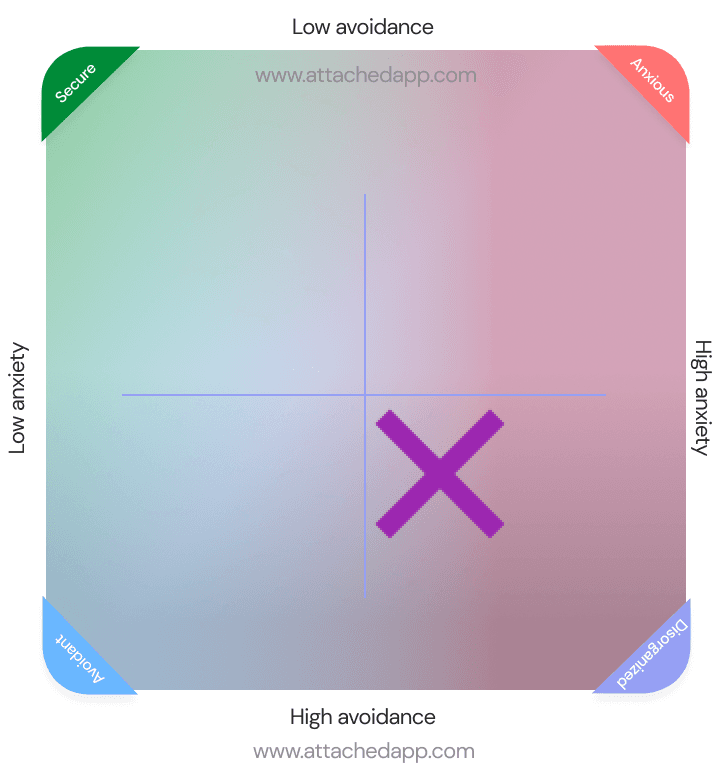What is Taylor Swift's Attachment Style? Let's Dive Deep and Analyze

What is Taylor Swift's Attachment Style? Let's Dive Deep and Analyze
Taylor Swift's lyrics and love stories hide a deeper emotional blueprint—and it's more complex than you think... Dive deep to discover her attachment style today.
Is it even a Tuesday afternoon if you're not scream-singing Cruel Summer in your car like it's a national emergency?
Taylor Swift's music has this magical way of making our feelings louder, sharper, and somehow better. But what if her songs also give us clues about something deeper—like her own attachment style?
Today, we're taking a (respectful) psychological deep dive into what Taylor's lyrics and life stories might reveal through the lens of attachment theory.

Chicago Tribune / TNS
Important: We cannot officially know anyone's attachment style without a professional assessment; this is not professional/medical advice or diagnosis.
Quick Overview: What Are Attachment Styles?
Attachment theory explains how early relationships shape how we connect with people as adults.
There are four main attachment styles:
- Secure: Comfortable with both closeness and independence.
- Anxious (Preoccupied): Craves closeness and fears being abandoned.
- Avoidant (Dismissive): Values independence and often pushes closeness away.
- Disorganized (Fearful-Avoidant): Wants love but fears it too; often feels torn between pulling people close and pushing them away.
Insecure attachment (anything that isn't secure) tends to stem from childhood experiences and mirrors our experiences with caregivers.
Possibility One - Is Taylor Anxiously Attached?

Anxious attachment shows up when someone craves love deeply but fears losing it. Taylor's lyrics and dating history reveal these anxious traits.
In Lyrics:
"Maybe we got lost in translation, maybe I asked for too much." — All Too Well
Blaming herself after a breakup is a hallmark anxious pattern—overanalyzing and worrying about being "too much."
"Maybe this is wishful thinkin', probably mindless dreamin'." — Back to December
Struggling to let go of past love shows emotional dependence and difficulty with closure.
"If you could see that I'm the one who understands you." — You Belong With Me
Seeking to be seen, validated, and chosen reflects anxious attachment's strong need for reassurance.
"I'll show you every version of yourself tonight."
"I'm still trying everything to get you laughing at me." — Mirrorball
Trying to change oneself to be loved and seeking constant approval—core anxious attachment traits.
"Wanting was enough / For me, it was enough." — August
Accepting emotional scraps and over-idealizing a relationship even when it was never fully mutual.
"I wait by the door like I'm just a kid."
"I made you my temple, my mural, my sky." — Tolerate It
Putting the partner on a pedestal and tolerating emotional neglect just to keep the relationship alive — textbook anxious attachment.
In Dating Patterns:
- Quick emotional investment: Several early relationships (like Joe Jonas, Taylor Lautner) moved fast emotionally, which matches anxious attachment's urge for quick intimacy.
- Visible heartbreak and regret: Songs after high-profile breakups (like with Harry Styles) showed deep emotional pain and a lingering connection long after relationships ended.
- Idealizing partners: Lyrics often place partners on a pedestal, common in anxious attachment where love is idealized and loss is devastating.
What this means:
Taylor's lyrics and dating history show a pattern of deep emotional investment, fear of losing love, and difficulty letting go—all linked to anxious attachment behaviors.
Possibility Two - Is Taylor Avoidantly Attached?

BETH GARRABRANT
Avoidant attachment shows up as emotional distancing, especially after feeling hurt. Taylor's work also hints at avoidant reactions.
In Lyrics:
"You call me up again just to break me like a promise / So casually cruel in the name of being honest." — All Too Well
After betrayal, there's a hard emotional shutdown—a move to protect herself from further vulnerability.
"This is me trying / And maybe I don't quite know what to say." — This Is Me Trying
Struggling to open up emotionally even when connection is desired points to avoidant conflict.
"I think I've seen this film before, and I didn't like the ending."
"You never gave a warning sign." — Exile
Avoidant language—expecting conflict, emotionally withdrawing early, and blaming others for not seeing the distance growing.
"I gave my blood, sweat, and tears for this / I hosted parties and starved my body."
"Everything you lose is a step you take." — You're On Your Own, Kid
Extreme self-reliance after emotional disappointment—avoidant belief that you're truly alone in the end.
"Don't get sad, get even." — Vigilante Sht*
Avoidant emotional style after betrayal—choosing revenge or detachment instead of emotional processing or vulnerability.
In Dating Patterns:
- Periods of withdrawal: After public relationship breakups (like Calvin Harris or Tom Hiddleston), Taylor stepped back significantly from the public dating scene, showing avoidance of emotional exposure.
What this means:
After emotional hurt, Taylor often pulled away from the public and from emotional vulnerability.
Possibility Three - Is Taylor Securely Attached?

PHOTO: SCOTT EISEN/TAS23/GETTY
Secure attachment balances emotional closeness and independence. Taylor's newer music and dating behavior reflect growth toward this emotional balance.
In Lyrics:
"I once believed love would be burning red, but it's golden, like daylight." — Daylight
Seeing love as steady and warm instead of chaotic shows emotional maturity.
"Wherever you stray, I follow."
"Life was a willow and it bent right to your wind." — Willow
Shows trust and emotional flexibility—not clingy or fearful, but flowing with the relationship's natural course.
"All that you ever wanted from me was sweet nothing." — Sweet Nothing
Reflects a calm, low-pressure, healthy relationship where Taylor feels loved without having to earn or perform for it—a huge shift from earlier anxious patterns.
In Dating Patterns:
- Longer, healthier relationship with Joe Alwyn: Over six years, Taylor maintained a stable, private relationship—something she hadn't done in earlier, more turbulent dating periods.
- Selective openness: Taylor now shares her emotions more thoughtfully, balancing honesty with boundaries, a sign of emotional security.
What this means:
Taylor's recent years show signs of secure attachment: healthier emotional boundaries, deeper self-awareness, and less chaos in relationships.
So, What Attachment Style Might Taylor Swift Have?

Looking closely at Taylor Swift's lyrics, interviews, and dating patterns, the strongest evidence points to disorganized (fearful-avoidant) attachment.
Why?
Her work shows both traits:
- Anxious traits—fear of abandonment, intense longing, and difficulty letting go (Back to December, All Too Well).
- Avoidant behaviors—emotional withdrawal after hurt (Exile, Cowboy Like Me).
This combination—wanting love but fearing vulnerability—are signs of disorganized attachment. Her emotional contradictions, swinging between deep connection and emotional self-protection, appear consistently across her music and personal patterns.
Importantly, Taylor's more recent songs (Daylight, Invisible String, Sweet Nothing) show signs of healing, suggesting growth toward greater emotional security.
TLDR:
Taylor Swift's emotional world mirrors disorganized attachment, but also shows how emotional awareness and growth can lead toward a more secure way of loving.
FAQ
Can someone be both anxious and avoidant at the same time?
Yes.
People with disorganized attachment often show both anxious and avoidant patterns. They crave connection but fear getting hurt.
Does this mean Taylor Swift has disorganized attachment?
We can't say for sure.
Only a professional assessment could confirm it. However, Taylor's lyrics, public stories, and dating patterns closely fit what research describes as disorganized (fearful-avoidant) attachment.
Why would someone develop disorganized attachment?
It often happens when early relationships are both comforting and frightening.
This teaches the brain that closeness might not be safe, creating confusion in adult relationships.
Can attachment styles change over time?
Yes.
Attachment styles can shift through self-awareness, healing, therapy, and healthy relationships. Taylor's later work suggests she's moving toward secure attachment.
How can you work on your attachment style and become more secure?
Recognizing emotional patterns helps. You can also:
- Learn about attachment.
- Practice emotional regulation.
- Reflect and journal about triggers.
- Build supportive relationships.
The Attached app helps make this process easier with:
- Daily Quests for habit-building.
- Help Mode for tough emotional moments.
- AI Journal to find hidden emotional patterns.
- Weekly Coaching from Eden, your relationship guide.
Download Attached for free and start working toward stronger emotional security.

